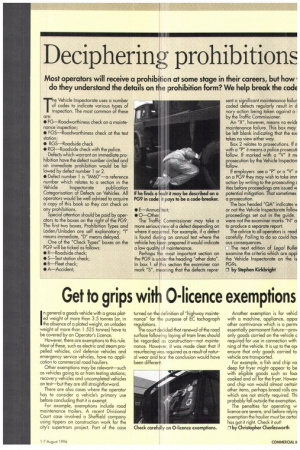Deciphering . prohibitions
Page 41

If you've noticed an error in this article please click here to report it so we can fix it.
Most operators will receive a prohibition at some stage in their careers, but how do they understand the details on the prohibition form? We help break the code
Toe Vehicle Inspectorate uses a number f codes to indicate various types of inspection. The most common of these are:
• FG—Roaclworthiness check on a maintenance inspection; • FGS—Roadworthiness check at the test station; • RGS—Roadside check • RGI—Roadside check with the police. Defects which warrant an immediate prohibition have the defect number circled and an immediate prohibition would be followed by defect number 1 or 2. • Defect number 1 is 1M60"—a reference number which relates to a section in the Vehicle Inspectorate publication Categorisation of Defects on Vehicles. All operators would be well advised to acquire a copy of this book so they can check on any prohibitions.
Special attention should be paid by operators to the boxes on the right of the PG9. The first two boxes, Prohibition Types and Laden/Unladen ore self explanatory; "I" means immediate, "D" means delayed. One of the "Check Types" boxes on the PG9 will be ticked as follows: • R—Roadside check; • S—Test station check; • B--Fleet check; • A—Accident; The Traffic Commissioner may take a more serious view of a defect depending on where it occurred. For example, if a defect is found dun i -g an annual test where the vehicle has beer prepared it would indicate a low !quality cif fnaintenance. Perhaps the most important section on the PG9 is uncler the heading "other data". In box 1 of this section the examiner can mark "5", meaning that the defects repre sent a significant maintenance failur coded defects regularly result in d nary action being taken against a I by the Traffic Commissioner. An "X", however, means no evid( maintenance failure. This box may be left blank indicating that the exi takes no view either way. Box 2 relates to prosecutions. If n with a "Fw it means a police prosecuti follow. If marked with a "V" it mi prosecution by the Vehicle Inspector( follow.
If employers see a "P" or a on a P09 they may wish to take imrr action by writing to the prosecuting ities before proceedings are issued w potential mitigation. That sometimes a prosecution.
The box headed "ON' indicates or not the Vehicle Inspectorate folliN, proceedings set out in the guide. were not the examiner marks "N" a to produce a separate report. The advice to all operators is read carefully. Failing to do so could ha' ous consequences.
The next edition of Legal Bullet examine the criteria which are appl the Vehicle Inspectorate on the is PG9s.
by Stephen Kirkbright




































































































